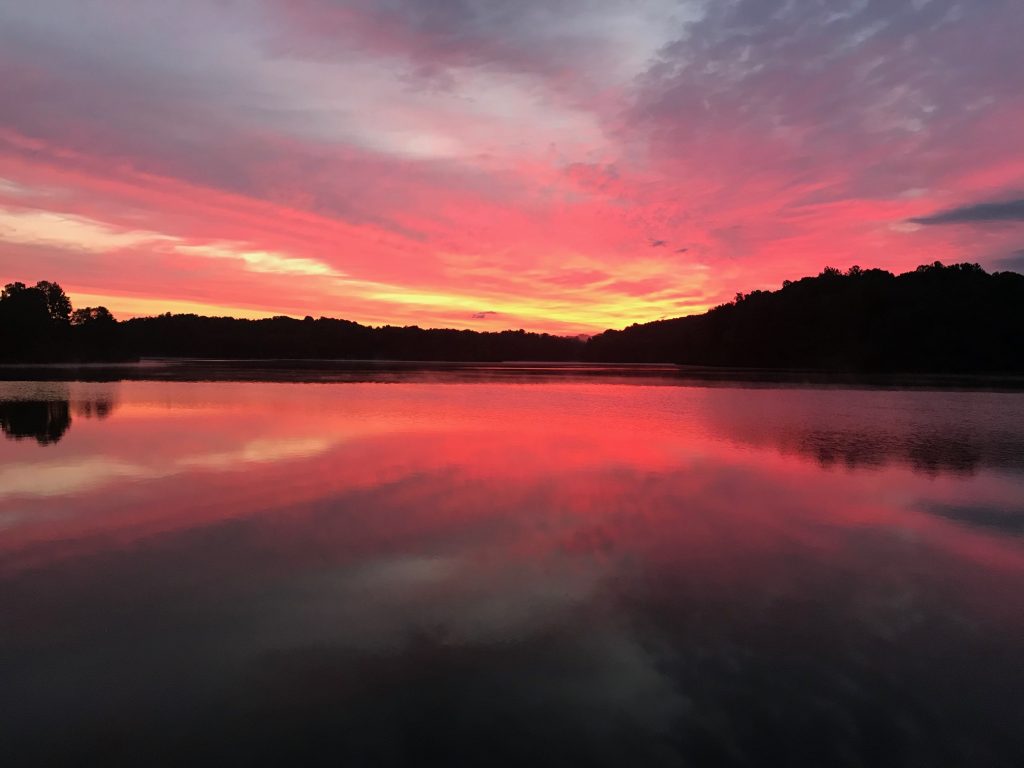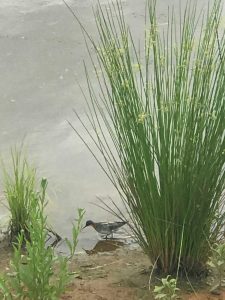By Eric Wallace

Amherst Lake, Home for Donna
Donna Mateski de Sanchez has singlehandedly completed nearly every priority block in Amherst County. Yet, she calls Atlasing her go-to form of relaxation.
After a long day of Atlasing in the Shenandoah National Park, Donna Mateski de Sanchez and her husband, Guillermo, intend to celebrate at Amherst’s Loose Shoe Brewing Company. Just before they pull into the parking lot, though, Donna suggests a detour. She’d noticed a newish stormwater retention pond in a nearby shopping center—which happens to fall within a priority block. Lined with reeds, high grasses, and shrubs, it could be home to hidden breeding birds.
“Guillermo was teasing me like I was some kind of crazy cat lady,” says Donna with a chuckle. Still, she insisted. Making their way to the pond, the couple spotted a mature female Red-necked Phalarope. Rarely sighted this far inland, the shorebird was taking a layover en route to Arctic breeding grounds. “It wasn’t a breeding confirmation, but it was cool find. And it totally changed Guillermo’s attitude about the pond. Now, whenever we’re heading to the brewery, he’ll ask, “Wanna stop and check out that pond?”

Donna at Las Cruces Biological Station, CR
Before the VABBA2, it wouldn’t have occurred to Donna to visit such a spot. Participating with the project has opened new realms of birding possibilities.
“One of the coolest things about the Atlas is that it’s forced me to explore [close-to-home] areas I probably wouldn’t have considered otherwise,” says Donna, a resident of Amherst County since 2003. Completing eight priority blocks in the area—and helping tag-team another three—she’s become intimately familiar with her hometown habitat. “It’s amazing what you can find once you know how to look,” she says. A trip to the grocery store may be accompanied by a walk to a hidden meadow. Visiting the recycling center offers a quick look at nearby ponds. “Atlasing has changed how I view and interact with the world around me. As birders, we’re surrounded by so much incredible nature, and yet, often times, we’re too busy planning our next big trip to really pay attention.”
Ironically, De Sanchez discovered birding by way of a 2002 trip to Costa Rica.
“I’d heard it was a hotspot and thought it would fun to branch out and do some exploring,” she says. Purchasing a guidebook, she made plans to visit interesting areas around San Jose. Though the diversity found in nearby National Parks amazed, the abundance of interesting species within the city affected her profoundly. Trips to the Simon Bolivar Park Zoo and National Botanical Gardens brought glimpses of more than 100 wild species. Then a resident of Washington D.C., she recognized many from trips to her vacation cabin in Nelson County.

Red-necked Phalarope at Ryan’s Pond (CO Donna Mateski de Sanchez)
“Seeing how the birds blended into everyday life—that hooked me,” says De Sanchez. “I came home and bought books. The more I learned, the more I wanted to know.”
The effect was boosted by meeting Guillermo, her husband-to-be. An avid birder and hiker, he encouraged Donna’s new interest. Looking to get closer to the Blue Ridge Mountains, the two moved to Amherst in 2003. Thelma Dalmas’s News and Advance column, “Naturally Speaking,” introduced them to the regional birding scene. By 2007, they’d joined the Lynchburg Bird Club and regularly attended fieldtrips. Memberships expanded to include the Roanoke Valley Bird Club, Virginia Society of Ornithology, and more.
“It was so helpful to be able to get together with other birders and learn skills,” says Donna. As a newbie, she wanted to increase her odds of seeing interesting species. “You’d never think hotspots could be found in off-the-wall places like a muddy little pond behind a Walmart. Getting out and birding with veterans taught us about habitat and the different kinds of birds they attract.”
In 2014, the De Sanchez’s participated in an American Birding Association Big Year. With a background in clinical research, Donna found the organized approach comforting. Meanwhile, the immersion helped her distress from a high-intensity position as the international regulatory affairs manager for C.B. Fleet Company Inc. Acquired by Prestige Consumer Healthcare in 2017, the Lynchburg-based company is affiliated with megabrands like Dramamine, Clear Eyes, Luden’s, and more.
“Getting outside in nature and systematically looking for birds helps me decompress,” explains Donna. When the Big Year concluded, she started looking for another project. The VABBA2 offered a next-level challenge. “I got so excited,” she continues. “I was doing research, gathering maps, and scouting areas for at least a year in advance.”
For the past three seasons, De Sanchez has been one of the VABBA2’s most dedicated participants. Many days find her waking at 4 a.m. to Atlas before work. Commutes home include stops for evening surveying. Weekends center around Atlasing. Data entry is basically a part-time job. And the offseason? That’s spent coordinating with project director Dr. Ashley Peele and other Atlasers to plan ahead for maximal impact. Looking at maps and taking fieldtrips to unexplored areas come next.
“Donna is a phenomenal volunteer who has been with the project from day one. Not only did she throw herself into data collection, but she makes the time to ask questions when uncertain field or data situations, say when she observes an unusual behavior and doesn’t know what breeding code is most appropriate. Plus! She has almost singlehandedly tackled Amherst County,” says Peele, who holds a doctoral degree in avian ecology. Additionally, De Sanchez has completed priority blocks in both the James River and Natural Bridge state parks, and helped with many others. She is presently working with area Atlasers to complete nocturnal survey hours and cross off more.
Donna’s participation has been so consuming, Guillermo has taken to jokingly calling Peele her real boss.

Great Blue fishing in Natural Bridge SE (CO Donna Mateski de Sanchez)
“I can’t begin to qualify how much this project has meant to me,” says Donna. “On one hand, Atlasing has introduced me to amazing nooks and crannies I never knew existed—and they’re right here in my back yard. On the other, I’ve learned so much about avian behavior. And that’s taken my birding to a whole new level. I feel infinitely more connected to where I live and the [area’s breeding birds] than I did three or four years ago.”
One of De Sanchez’s favorite examples is discovering Wilderness Creek Road. Winding through the mountainous southwestern corner of the county, its name is telling. In addition to rural tranquility, the final 3-mile stretch brought a staggering array of habitat—and glimpses of at least 51 different species.
A section of mixed woods bordering a small clear-cutting offered sights of Woodcock, Eastern Whip-poor-will, and numerous warblers. Two-hundred yards later, a pair of Blue Grosbeaks and a male Orchard Oriole were spotted in the high grass of an un-mowed field. The road deadended at the James River, yielding views of waterfowl, Osprey, and herons.
“It went from something I’d never heard about to one of my favorite spots,” says De Sanchez. Accordingly, she hopes to coordinate a fieldtrip with the Lynchburg Bird Club. “But that’s the magic of the Atlas: Without it, I would have never known this place existed.”

